As we move toward 2025, the construction industry is on the brink of a technological revolution, particularly in the realm of construction cranes. These vital pieces of equipment are not only essential for lifting heavy materials but are also becoming increasingly sophisticated with advancements in automation, safety features, and sustainability. In this blog, we will delve into the innovative trends shaping the future of construction cranes and provide effective strategies for global buyers looking to optimize their purchasing decisions. Understanding these developments is crucial for staying competitive in a rapidly evolving market. Whether you are an industry expert or a newcomer, this guide will equip you with insights and practical approaches to navigating the complex landscape of construction crane acquisition, ensuring you are well-prepared to meet the demands of modern construction projects.

The future of construction cranes is set to be transformed by
innovative technologies that enhance
safety, efficiency, and operational performance. One of the standout advancements
is the launch of an anti-collision system
that integrates functionalities between tower and mobile cranes, demonstrating a
significant leap in project site management. This system, which can automatically
detect and manage multiple cranes, represents a world-first innovation
aimed at minimizing accidents and streamlining workflows on busy job sites.
Additionally, the introduction of
luffing jib tower cranes showcases how
manufacturers are responding to the industry's evolving demands for faster and
safer project completion. These cranes are equipped with advanced technology
that improves control and speed, essential factors for meeting tight deadlines in
contemporary construction projects. Furthermore, the application of
embedded visualizations in crane operation
interfaces is revolutionizing the way operators interact with their machinery,
offering real-time assistance that enhances safety and decision-making
on the job. As these technologies continue to emerge, global buyers in the
construction sector can look forward to transformative changes in crane design and
functionality by 2025.
As the construction industry evolves, the integration of automation and robotics in crane operations is set to transform the landscape by 2025. These technological advancements aim to enhance safety and efficiency on job sites while minimizing human error. Automated cranes equipped with sophisticated sensors and AI-driven software can now detect obstacles and optimize lifting processes, ensuring operations proceed without incident. This not only increases productivity but also significantly reduces the risk of accidents, making construction sites safer for workers.

Robotics also play a crucial role in redefining crane operations. Remote-controlled cranes enable operators to manage lifting tasks from a safe distance, further mitigating potential hazards associated with traditional methods. The use of drones for real-time site assessments allows for precise planning and execution, ensuring that cranes are utilized effectively. With these innovations, global buyers can anticipate a shift toward more intelligent machinery that aligns with stringent safety standards and caters to the increasing demands of modern construction projects.
As we move closer to 2025, embracing these advancements will be essential for anyone looking to thrive in the competitive construction market.
As we move towards 2025, the construction industry faces increasing pressure to adopt sustainable practices. Eco-friendly crane solutions are at the forefront of this transformation, with innovations aimed at minimizing environmental impact. Reports indicate that the global demand for environmentally-friendly construction equipment is projected to grow at a compound annual growth rate (CAGR) of 7.5% from 2021 to 2027. Companies are now investing in electric and hybrid cranes, which not only reduce emissions but also lower operational costs over time.
In addition to electric solutions, new materials and designs are enhancing the sustainability of construction cranes. Using lightweight yet durable materials like high-strength steel and composites can improve fuel efficiency and reduce energy consumption. According to a study by the Global Construction Review, implementing greener technologies in construction could lead to a 30% decrease in carbon emissions by 2030. As global buyers prepare for the future, embracing these eco-friendly options will not only comply with increasingly stringent regulations but also align with the growing consumer demand for sustainable practices in construction.
This chart illustrates the projected adoption rates of various eco-friendly crane solutions by 2025. As the construction industry shifts towards more sustainable practices, it is crucial for global buyers to understand these trends.
As the construction industry gears up for 2025, international buyers need to stay ahead of the curve regarding global market trends in crane innovations. Research indicates that the overall construction equipment market is projected to reach approximately $200 billion by 2025, driven by the rising demand for smart and efficient machinery. With developments in automation and telematics, cranes are evolving to meet the demands for enhanced efficiency, safety, and sustainability. Buyers must pay close attention to these technological advancements, which are reshaping operational capabilities and competitive advantages.
In the realm of cross-border e-commerce, buyers should leverage data illustrating that 85% of consumers are now inclined to purchase products from overseas. Particularly for construction cranes and related equipment, understanding the nuances of supply chain logistics and tariffs is essential. The recent trends highlight that seamless access to international markets is more crucial than ever, as companies adapt to shifting trade dynamics. Buyers should also consider establishing relationships with key suppliers who are leveraging global platforms to enhance visibility and streamline cross-border transactions. This strategic approach will be invaluable in navigating the complexities of the global marketplace in 2025.
| Cranes Type | Market Share (%) 2025 | Expected Growth Rate (%) 2025 | Key Features | Sustainability Innovations |
|---|---|---|---|---|
| Tower Cranes | 35% | 6% | Higher lifting capacity, improved visibility | Energy-efficient motors, recyclable materials |
| Mobile Cranes | 25% | 5% | Versatile maneuverability, fast setup | Hybrid power systems, fuel-efficient designs |
| Crawler Cranes | 18% | 4% | Stability on uneven ground, high load capacity | Low emissions, advanced tracking systems |
| Floating Cranes | 12% | 3% | Ideal for maritime operations, large lifting capacity | Solar power integration, eco-friendly materials |
| Truck-mounted Cranes | 10% | 2% | Mobility, compact design | Biofuel compatibility, efficiency monitoring |
In the ever-evolving construction industry, selecting the right cranes is pivotal for project success. With the global construction crane market projected to reach $18.28 billion by 2025, navigating the competitive landscape requires effective strategies. Buyers should prioritize understanding the specific needs of their projects, such as load capacity and reach. Utilizing data from the National Association of Heavy Equipment Training Schools, 45% of equipment failures are attributed to improper selection, highlighting the necessity for informed decision-making.

Moreover, leveraging technology in the sourcing process is essential. Studies show that companies integrating digital platforms for procurement witness a 20% reduction in costs and a 30% improvement in lead times. By adopting Building Information Modeling (BIM) and other advanced analytics tools, buyers can enhance collaboration with suppliers and ensure they are getting the most suitable cranes for their needs. As the industry embraces innovation, staying updated on technological advancements will empower global buyers to make strategic, informed choices in their crane procurement efforts.


